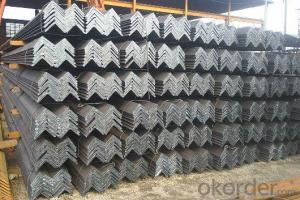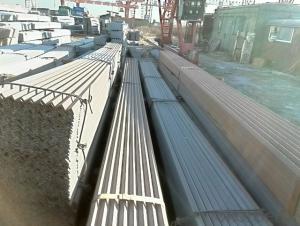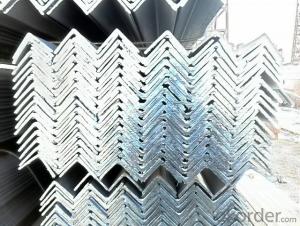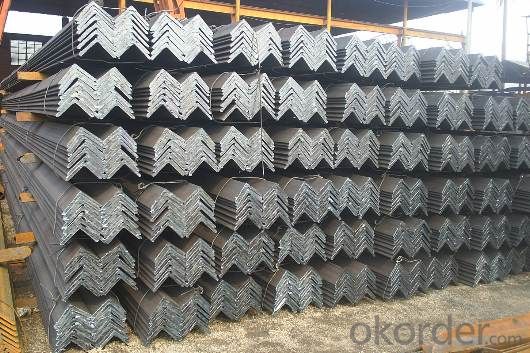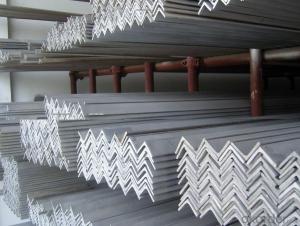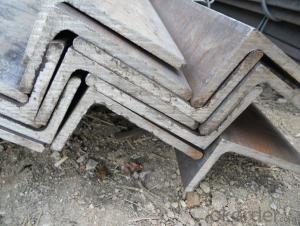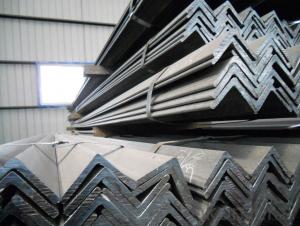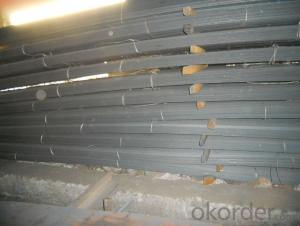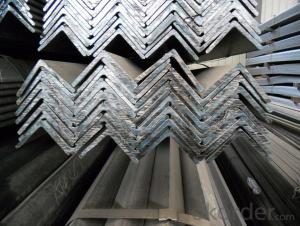Hot Rolled Equal Angle Steel with Best Price
- Loading Port:
- Tianjin
- Payment Terms:
- TT OR LC
- Min Order Qty:
- 25 m.t.
- Supply Capability:
- 20000 m.t./month
OKorder Service Pledge
OKorder Financial Service
You Might Also Like
Product Description:
OKorder is offering high quality Hot Rolled Equal Angle Steel at great prices with worldwide shipping. Our supplier is a world-class manufacturer of steel, with our products utilized the world over. OKorder annually supplies products to European, North American and Asian markets. We provide quotations within 24 hours of receiving an inquiry and guarantee competitive prices.
Product Applications:
Hot Rolled Equal Angle Steels are ideal for structural applications and are widely used in the construction of buildings and bridges, and the manufacturing, petrochemical, and transportation industries.
Product Advantages:
OKorder's Hot Rolled Equal Angle Steels are durable, strong, and resist corrosion.
Main Product Features:
· Premium quality
· Prompt delivery & seaworthy packing (30 days after receiving deposit)
· Corrosion resistance
· Can be recycled and reused
· Mill test certification
· Professional Service
· Competitive pricing
Product Specifications:
Manufacture: Hot rolled
Grade: Q195 – 235
Certificates: ISO, SGS, BV, CIQ
Length: 6m – 12m, as per customer request
Packaging: Export packing, nude packing, bundled
Sizes: 25mm-250mm | ||
a*t | ||
25*2.5-4.0 | 70*6.0-9.0 | 130*9.0-15 |
30*2.5-6.6 | 75*6.0-9.0 | 140*10-14 |
36*3.0-5.0 | 80*5.0-10 | 150*10-20 |
38*2.3-6.0 | 90*7.0-10 | 160*10-16 |
40*3.0-5.0 | 100*6.0-12 | 175*12-15 |
45*4.0-6.0 | 110*8.0-10 | 180*12-18 |
50*4.0-6.0 | 120*6.0-15 | 200*14-25 |
60*4.0-8.0 | 125*8.0-14 | 250*25 |
FAQ:
Q1: Why buy Materials & Equipment from OKorder.com?
A1: All products offered byOKorder.com are carefully selected from China's most reliable manufacturing enterprises. Through its ISO certifications, OKorder.com adheres to the highest standards and a commitment to supply chain safety and customer satisfaction.
Q2: What makes stainless steel stainless?
A2: Stainless steel must contain at least 10.5 % chromium. It is this element that reacts with the oxygen in the air to form a complex chrome-oxide surface layer that is invisible but strong enough to prevent further oxygen from "staining" (rusting) the surface. Higher levels of chromium and the addition of other alloying elements such as nickel and molybdenum enhance this surface layer and improve the corrosion resistance of the stainless material.
Q3: Can stainless steel rust?
A3: Stainless does not "rust" as you think of regular steel rusting with a red oxide on the surface that flakes off. If you see red rust it is probably due to some iron particles that have contaminated the surface of the stainless steel and it is these iron particles that are rusting. Look at the source of the rusting and see if you can remove it from the surface.
Images:
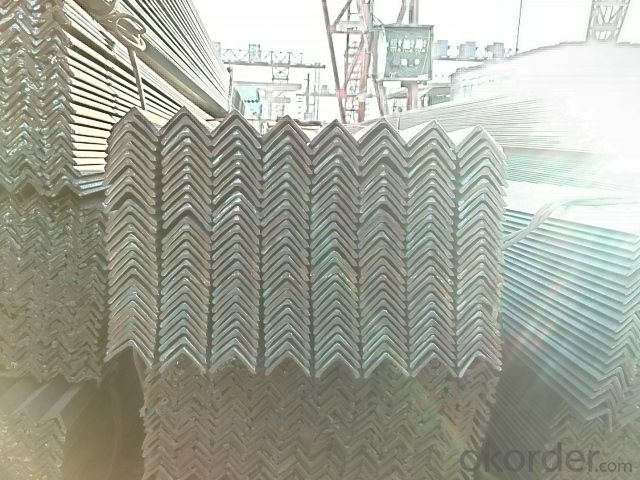
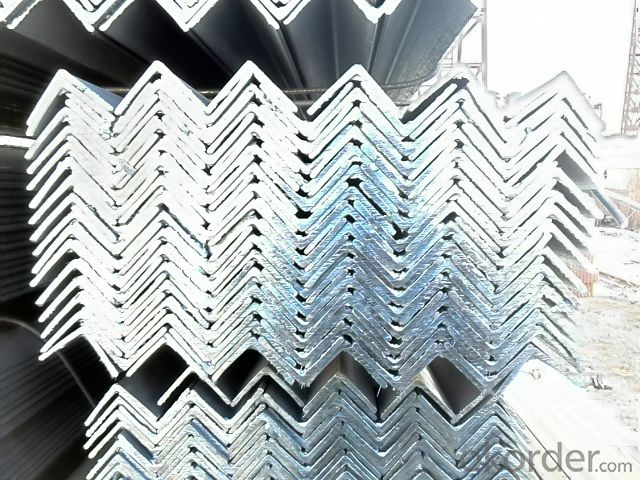

- Q: How do steel angles perform in high-humidity environments?
- Steel angles perform well in high-humidity environments due to their corrosion-resistant properties. The presence of moisture in the air can often lead to rust and corrosion of metals, but steel angles are designed to withstand these conditions. They are typically made from stainless steel or galvanized steel, both of which have a protective layer that prevents rust formation. This makes them highly suitable for use in areas with high humidity, such as coastal regions or industrial settings where moisture is prevalent. Additionally, steel angles are durable and have a long lifespan, further enhancing their performance in high-humidity environments.
- Q: Can steel angles be used for support structures?
- Support structures can indeed utilize steel angles. In the construction and engineering sectors, these angles are frequently employed for a range of purposes, including delivering stability and support to structures. The inherent L-shape of steel angles facilitates simple bolting or welding, rendering them ideal for crafting robust and long-lasting support structures. Common applications include building frames, roof trusses, bridges, and industrial platforms. Furthermore, steel angles possess exceptional load-bearing capacity and the ability to withstand bending and twisting forces, thus establishing themselves as a dependable option for support structures.
- Q: Can steel angles be used in earthquake-prone areas?
- Yes, steel angles can be used in earthquake-prone areas. Steel angles are commonly used in construction due to their strength and ability to resist seismic forces. They can be incorporated into the design of buildings and structures to provide added stability and support during earthquakes. However, it is essential to ensure that the steel angles are properly designed and installed according to the seismic design codes and regulations of the specific region to ensure maximum safety.
- Q: Can steel angles be used for support brackets in electrical installations?
- Yes, steel angles can be used as support brackets in electrical installations. Steel angles provide strength, durability, and stability, making them suitable for supporting heavy electrical equipment or mounting electrical panels securely. Additionally, their rigid structure ensures proper alignment and minimizes the risk of shifting or sagging over time.
- Q: Are steel angles available in different finishes?
- Yes, steel angles are available in different finishes. Steel angles can be finished with various coatings or treatments to enhance their appearance or provide additional protection against corrosion. Some common finishes for steel angles include galvanized, painted, or powder-coated finishes. Galvanized steel angles are coated with a layer of zinc to prevent rusting, while painted or powder-coated finishes offer a wide range of color options for aesthetic purposes. Additionally, steel angles can also be left unfinished, which gives them a raw, industrial look. The availability of different finishes for steel angles allows for greater versatility in their applications, as they can be tailored to meet specific functional and aesthetic requirements.
- Q: Can steel angles be used for manufacturing storage racks?
- Indeed, storage racks can be manufactured using steel angles. With their versatility and strength, steel angles prove to be an optimal option for the construction of such racks. By providing stability and structural integrity, they guarantee the capability to bear substantial loads. Moreover, steel angles allow for the seamless welding or bolting together, enabling the production of tailor-made racks that satisfy specific storage needs. The longevity of steel angles further assures the endurance of the storage racks against gradual deterioration. As a result, steel angles find widespread application in the manufacturing of storage racks across diverse industries encompassing warehousing, retail, and logistics.
- Q: Can steel angles be used in fencing?
- Yes, steel angles can be used in fencing. Steel angles are commonly used in fencing applications to provide structural support and stability. They can be used as posts or crossbars, depending on the specific fencing design. Steel angles are strong and durable, making them suitable for withstanding the elements and providing security. They can be easily welded or bolted together to create a sturdy fencing structure. Additionally, steel angles can be galvanized or coated to enhance their resistance to rust and corrosion, ensuring a long-lasting and low-maintenance fencing solution.
- Q: Can steel angles be used for stairs in industrial settings?
- In industrial settings, stairs can indeed utilize steel angles. The construction industry often employs steel angles for a wide range of purposes, including staircases. Their strength and durability make them particularly well-suited for industrial environments where safety and robustness are paramount. By providing structural support and stability, steel angles enable staircases to endure heavy loads and frequent usage. Moreover, the ease of welding steel angles ensures that the resulting staircase is secure and long-lasting. Additionally, steel angles offer versatility, allowing for customization to meet specific design and spatial needs. As a result, steel angles are an appropriate option for stairs in industrial settings.
- Q: Can steel angles be used as supports for mechanical or electrical equipment?
- Indeed, mechanical or electrical equipment can be supported by steel angles. Due to their versatility and strength, steel angles are apt for a diverse array of uses. They offer stability, rigidity, and support, effectively securing mechanical or electrical equipment. The L-shaped configuration of steel angles facilitates effortless attachment and installation, rendering them convenient for a multitude of mounting necessities. Moreover, steel angles can be readily tailored and fabricated to fulfill precise specifications, guaranteeing a dependable and trustworthy support system for the equipment.
- Q: How do steel angles perform in terms of energy efficiency?
- Steel angles can be an energy-efficient option depending on their design and application. The energy efficiency of steel angles primarily depends on factors such as the type and thickness of the steel used, the manufacturing process employed, and the installation techniques. One aspect that contributes to the energy efficiency of steel angles is their thermal conductivity. Steel, being a conductive material, can transfer heat quickly, which can be advantageous in certain applications. For instance, steel angles can efficiently conduct heat away from building components in cooling systems, helping to maintain desired temperature levels and reduce energy consumption. Furthermore, steel angles can be designed to optimize their structural performance, reducing the need for additional materials or construction methods. This can result in lower energy usage during the manufacturing and installation processes. Additionally, steel angles can be recycled, making them an environmentally friendly choice. The energy required to recycle steel is significantly lower compared to producing it from raw materials. This reduces the energy demand and greenhouse gas emissions associated with steel production. However, it is important to note that the overall energy efficiency of steel angles also depends on their application and the overall design of the structure. Proper insulation, sealing, and design considerations are crucial to ensure optimal energy efficiency. It is recommended to consult with professionals and engineers to determine the most efficient use of steel angles in specific projects. In conclusion, steel angles can offer energy-efficient solutions when used appropriately. By considering factors such as thermal conductivity, structural optimization, and recyclability, steel angles can contribute to reducing energy consumption and promoting sustainability in various applications.
Send your message to us
Hot Rolled Equal Angle Steel with Best Price
- Loading Port:
- Tianjin
- Payment Terms:
- TT OR LC
- Min Order Qty:
- 25 m.t.
- Supply Capability:
- 20000 m.t./month
OKorder Service Pledge
OKorder Financial Service
Similar products
Hot products
Hot Searches
Related keywords
